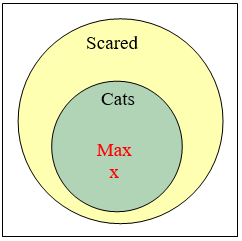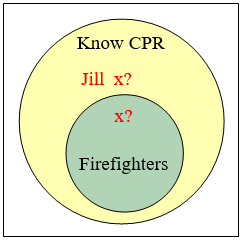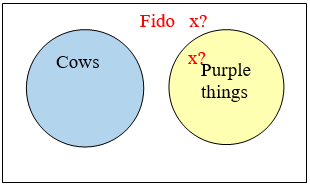3.5: Using Venn Diagrams to Analyze Arguments
- Page ID
- 92459
\( \newcommand{\vecs}[1]{\overset { \scriptstyle \rightharpoonup} {\mathbf{#1}} } \)
\( \newcommand{\vecd}[1]{\overset{-\!-\!\rightharpoonup}{\vphantom{a}\smash {#1}}} \)
\( \newcommand{\id}{\mathrm{id}}\) \( \newcommand{\Span}{\mathrm{span}}\)
( \newcommand{\kernel}{\mathrm{null}\,}\) \( \newcommand{\range}{\mathrm{range}\,}\)
\( \newcommand{\RealPart}{\mathrm{Re}}\) \( \newcommand{\ImaginaryPart}{\mathrm{Im}}\)
\( \newcommand{\Argument}{\mathrm{Arg}}\) \( \newcommand{\norm}[1]{\| #1 \|}\)
\( \newcommand{\inner}[2]{\langle #1, #2 \rangle}\)
\( \newcommand{\Span}{\mathrm{span}}\)
\( \newcommand{\id}{\mathrm{id}}\)
\( \newcommand{\Span}{\mathrm{span}}\)
\( \newcommand{\kernel}{\mathrm{null}\,}\)
\( \newcommand{\range}{\mathrm{range}\,}\)
\( \newcommand{\RealPart}{\mathrm{Re}}\)
\( \newcommand{\ImaginaryPart}{\mathrm{Im}}\)
\( \newcommand{\Argument}{\mathrm{Arg}}\)
\( \newcommand{\norm}[1]{\| #1 \|}\)
\( \newcommand{\inner}[2]{\langle #1, #2 \rangle}\)
\( \newcommand{\Span}{\mathrm{span}}\) \( \newcommand{\AA}{\unicode[.8,0]{x212B}}\)
\( \newcommand{\vectorA}[1]{\vec{#1}} % arrow\)
\( \newcommand{\vectorAt}[1]{\vec{\text{#1}}} % arrow\)
\( \newcommand{\vectorB}[1]{\overset { \scriptstyle \rightharpoonup} {\mathbf{#1}} } \)
\( \newcommand{\vectorC}[1]{\textbf{#1}} \)
\( \newcommand{\vectorD}[1]{\overrightarrow{#1}} \)
\( \newcommand{\vectorDt}[1]{\overrightarrow{\text{#1}}} \)
\( \newcommand{\vectE}[1]{\overset{-\!-\!\rightharpoonup}{\vphantom{a}\smash{\mathbf {#1}}}} \)
\( \newcommand{\vecs}[1]{\overset { \scriptstyle \rightharpoonup} {\mathbf{#1}} } \)
\( \newcommand{\vecd}[1]{\overset{-\!-\!\rightharpoonup}{\vphantom{a}\smash {#1}}} \)
\(\newcommand{\avec}{\mathbf a}\) \(\newcommand{\bvec}{\mathbf b}\) \(\newcommand{\cvec}{\mathbf c}\) \(\newcommand{\dvec}{\mathbf d}\) \(\newcommand{\dtil}{\widetilde{\mathbf d}}\) \(\newcommand{\evec}{\mathbf e}\) \(\newcommand{\fvec}{\mathbf f}\) \(\newcommand{\nvec}{\mathbf n}\) \(\newcommand{\pvec}{\mathbf p}\) \(\newcommand{\qvec}{\mathbf q}\) \(\newcommand{\svec}{\mathbf s}\) \(\newcommand{\tvec}{\mathbf t}\) \(\newcommand{\uvec}{\mathbf u}\) \(\newcommand{\vvec}{\mathbf v}\) \(\newcommand{\wvec}{\mathbf w}\) \(\newcommand{\xvec}{\mathbf x}\) \(\newcommand{\yvec}{\mathbf y}\) \(\newcommand{\zvec}{\mathbf z}\) \(\newcommand{\rvec}{\mathbf r}\) \(\newcommand{\mvec}{\mathbf m}\) \(\newcommand{\zerovec}{\mathbf 0}\) \(\newcommand{\onevec}{\mathbf 1}\) \(\newcommand{\real}{\mathbb R}\) \(\newcommand{\twovec}[2]{\left[\begin{array}{r}#1 \\ #2 \end{array}\right]}\) \(\newcommand{\ctwovec}[2]{\left[\begin{array}{c}#1 \\ #2 \end{array}\right]}\) \(\newcommand{\threevec}[3]{\left[\begin{array}{r}#1 \\ #2 \\ #3 \end{array}\right]}\) \(\newcommand{\cthreevec}[3]{\left[\begin{array}{c}#1 \\ #2 \\ #3 \end{array}\right]}\) \(\newcommand{\fourvec}[4]{\left[\begin{array}{r}#1 \\ #2 \\ #3 \\ #4 \end{array}\right]}\) \(\newcommand{\cfourvec}[4]{\left[\begin{array}{c}#1 \\ #2 \\ #3 \\ #4 \end{array}\right]}\) \(\newcommand{\fivevec}[5]{\left[\begin{array}{r}#1 \\ #2 \\ #3 \\ #4 \\ #5 \\ \end{array}\right]}\) \(\newcommand{\cfivevec}[5]{\left[\begin{array}{c}#1 \\ #2 \\ #3 \\ #4 \\ #5 \\ \end{array}\right]}\) \(\newcommand{\mattwo}[4]{\left[\begin{array}{rr}#1 \amp #2 \\ #3 \amp #4 \\ \end{array}\right]}\) \(\newcommand{\laspan}[1]{\text{Span}\{#1\}}\) \(\newcommand{\bcal}{\cal B}\) \(\newcommand{\ccal}{\cal C}\) \(\newcommand{\scal}{\cal S}\) \(\newcommand{\wcal}{\cal W}\) \(\newcommand{\ecal}{\cal E}\) \(\newcommand{\coords}[2]{\left\{#1\right\}_{#2}}\) \(\newcommand{\gray}[1]{\color{gray}{#1}}\) \(\newcommand{\lgray}[1]{\color{lightgray}{#1}}\) \(\newcommand{\rank}{\operatorname{rank}}\) \(\newcommand{\row}{\text{Row}}\) \(\newcommand{\col}{\text{Col}}\) \(\renewcommand{\row}{\text{Row}}\) \(\newcommand{\nul}{\text{Nul}}\) \(\newcommand{\var}{\text{Var}}\) \(\newcommand{\corr}{\text{corr}}\) \(\newcommand{\len}[1]{\left|#1\right|}\) \(\newcommand{\bbar}{\overline{\bvec}}\) \(\newcommand{\bhat}{\widehat{\bvec}}\) \(\newcommand{\bperp}{\bvec^\perp}\) \(\newcommand{\xhat}{\widehat{\xvec}}\) \(\newcommand{\vhat}{\widehat{\vvec}}\) \(\newcommand{\uhat}{\widehat{\uvec}}\) \(\newcommand{\what}{\widehat{\wvec}}\) \(\newcommand{\Sighat}{\widehat{\Sigma}}\) \(\newcommand{\lt}{<}\) \(\newcommand{\gt}{>}\) \(\newcommand{\amp}{&}\) \(\definecolor{fillinmathshade}{gray}{0.9}\)Students will be able to
- Use Venn diagrams to analyze arguments
When you hear people arguing, what do you think of? Yelling? Screaming? No good, right? Here arguments are placed within the context of logic. So, what is an argument to the logistician? Read on!
An argument is a collection of premises intended to support or infer a conclusion. Each premise must be either true or false.
The definition above may seem the same as "reasoning" from the prior section (look back there if needed). The key difference is the additional requirement of the premises being true or false. Take the inductive reasoning, "It was hot yesterday, it is hot today, and therefore it will be hot tomorrow." The idea of "hot" is neither true nor false, rather it is an opinion. The statement is not an argument, just inductive reasoning. In an argument, we must be able to assign the values of either true or false to each premise. Once we are sure we have an argument, we can then analyze it.
A syllogism is a specific type of argument that consists of two premises and a conclusion.
An argument is considered valid if the conclusion of the argument is guaranteed under its given set of premises. Otherwise, the argument is invalid.
The concept of validity does not apply to arguments that involve inductive reasoning. Take, for example, the premises, "I knocked down the first domino, and the first domino knocked down the second, then the second knocked down the third" and the conclusion, "the third domino will knock down the fourth". Are we guaranteed that the fourth domino will fall? No. Surely it is the most likely outcome, but cannot be guaranteed. When analyzing inductive arguments, we describe them as either being "strong" or "weak". Certainly, I would consider the "domino" argument "strong".
So, the only types of arguments we will analyze are deductive arguments. There are two common tools to analyze deductive arguments, Venn Diagrams, and Truth Tables. The remainder of this section will be devoted to determining the validity of syllogisms using Venn Diagram. Truth Tables are a more general and quite powerful tool to determine the validity of an argument and will be presented in a subsequent section.
To analyze a deductive argument with a Venn diagram:
1) Draw a Venn diagram based on the premises.
2) The argument is invalid if there is a way to draw the diagram that makes the conclusion false
3) The reasoning is valid if the diagram cannot be drawn to make the conclusion false
4) If the premises are insufficient to determine the location of an element or a set mentioned in the conclusion, then the reasoning is invalid.
Consider the statements “All cats are mammals and a tiger is a cat, so a tiger is a mammal.” Identify the premises and conclusion. Is this an argument? Why? and if so is the argument valid? Show with a Venn Diagram.
Solution
 The premises are:
The premises are:
- All cats are mammals.
- A tiger is a cat.
The conclusion is:
- A tiger is a mammal.
This is an argument because the premises are either true or false (they just both happen to be true) and the argument is valid. From the first premise, we draw the set of cats as a subset of the set of mammals. From the second premise, we are told that a tiger is contained within the set of cats. From that, we can see in the Venn diagram that the tiger must also be inside the set of mammals, so there is no way of drawing the diagram to make the conclusion false. This is a valid argument!
A common misunderstanding about the validity of an argument is that the premises must be true. If the premises are all true for a valid argument, then we say the argument is "sound". The next example shows how an argument can still be valid even though there is a false premise. In such circumstances, the argument is called "unsound".
Determine the validity of this argument using a Venn Diagram:
\(\begin{array} {ll} \text{Premise:} & \text{All cats are scared of vacuum cleaners.} \\ \text{Premise:} & \text{Max is a cat.} \\ \text{Conclusion:} & \text{Max is scared of vacuum cleaners.} \end{array}\)
- Solution
-
Valid. Cats are a subset of creatures that are scared by vacuum cleaners. Max is in the set of cats, so he must also be in the set of creatures that are scared by vacuum cleaners. Since the premise "All cats are scared of vacuum cleaners" is false, yet the argument is valid, the argument is unsound.
If an argument is invalid, then the argument is unsound. So, both valid and invalid arguments can be "unsound", but only valid arguments can be "sound".
Determine the validity of this argument using a Venn Diagram
\(\begin{array} {ll} \text{Premise:} & \text{All firefighters know CPR.} \\ \text{Premise:} & \text{Jill knows CPR.} \\ \text{Conclusion:} & \text{Jill is a firefighter.} \end{array}\)
Solution
From the first premise, we know that firefighters all lie inside the set of those who know CPR. (Firefighters are a subset of people who know CPR.) From the second premise, we know that Jill is a member of that larger set, but we do not have enough information to know whether she also is a member of the smaller subset that is firefighters.
Since the conclusion does not necessarily follow from the premises, this is an invalid argument. It’s possible that Jill is a firefighter, but the structure of the argument doesn’t allow us to conclude that she definitely is.
It is important to note that whether or not Jill is actually a firefighter is not important in evaluating the validity of the reasoning; we are concerned with whether the premises are enough to prove the conclusion.
Each example above had a common structure in its premises. "All cats are mammals", "All cats are scared of vacuum cleaners", and "All firefighters know CPR". In general, "All A are B." This commonality is called the Universal Affirmative. Below are four common premise structures that are used in arguments along with the Venn Diagram for each. Making sense of these diagrams should help in creating a Venn Diagram to determine the validity of an argument.
Universal Affirmative: All A are B.

Universal Negative: No A are B.

Particular Affirmative: Some A are B. Please note that the "x" signifies that there is at least one A is B

Particular Negative: Some A are not B. The "x" signifies that there is at least one A is not B.

Determine the validity of this argument using a Venn Diagram:
\(\begin{array} {ll} \text{Premise:} & \text{No cows are purple.} \\ \text{Premise:} & \text{Fido is not a cow.} \\ \text{Conclusion:} & \text{Fido is purple.} \end{array}\)
Solution
The first premise is the universal negative, so there is no overlap between the set of cows and the set of purple things. We know Fido is not in the cow set, but that is not enough to conclude that Fido is in the purple things set. This argument is invalid.

